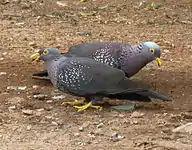African olive pigeon
The African olive pigeon or Rameron pigeon (Columba arquatrix) is a pigeon which is a resident breeding bird in much of eastern and southern Africa from Ethiopia to the Cape. Populations also are found in western Angola, southwestern Saudi Arabia and northern Yemen. It is locally common, although sizeable gaps in its distribution occur due to its habitat requirements.
| African olive pigeon | |
|---|---|
 | |
| Scientific classification | |
| Kingdom: | Animalia |
| Phylum: | Chordata |
| Class: | Aves |
| Order: | Columbiformes |
| Family: | Columbidae |
| Genus: | Columba |
| Species: | C. arquatrix |
| Binomial name | |
| Columba arquatrix Temminck, 1808 | |
 | |
| distribution | |
Description
The adult male African olive pigeon is a large pigeon at 37 to 42 cm (15 to 17 in) in length and a weight of 300 to 450 g (11 to 16 oz).[2][3][4] Its back and wings are maroon, with the shoulders heavily speckled with white spots. The underparts are maroon with heavy white spotting, and the head is grey with yellow patches around the eye, and a yellow bill. The neck plumage, used in display, is streaked maroon and white, the underwing and undertail are dark grey, and the feet are yellow.
Females are very similar but somewhat duller. Juvenile birds have the maroon and grey replaced with dark brown, the bare parts are a dull greenish-yellow, and the wing feathers have pale fringes. In flight, this pigeon looks very dark. Its flight is quick, with the regular beats and an occasional sharp flick of the wings which are characteristic of pigeons in general. The call is a loud coo coo.
Habitat
This is a species of cool, moist forest canopies above 1,400 m altitude, although it occurs locally as low as 700 m. It will use mountain fynbos, second growth, and clearings, and feed on agricultural land when not persecuted.
Behaviour
Breeding
The African olive pigeon builds a large stick nest up to 15 m high in a tree and lays one (rarely two) white eggs. The eggs are incubated for 17–20 days to hatching, and the chicks fledge in another 20 days.
The male has a display consisting of deep bows, and a display flight which consists of a climb, wing clapping, and slow glide down.
Feeding
The African olive pigeon feeds on fruit and berries, mainly picked in the canopy, but it will also descend for fallen fruit and take some insects and caterpillars. In the south of its range, it favours the fruit of a highly invasive plant, the bugweed, Solanum mauritianum. Birds fly considerable distances from their roosts to feeding areas, and young or nonbreeding birds form flocks.
Gallery


At a clay lick 
Nesting
References
- BirdLife International (2012). "Columba arquatrix". IUCN Red List of Threatened Species. 2012. Retrieved 26 November 2013.CS1 maint: ref=harv (link)
- "Rameron (African olive) pigeon - Columba arquatrix : WAZA : World Association of Zoos and Aquariums". WAZA. Archived from the original on 2013-12-03. Retrieved 2012-08-24.
- "African Olive Pigeon (Columba arquatrix fam. columbidae) Kruger Park Birds & Birding". Thekruger.com. 2010-09-15. Retrieved 2012-08-24.
- Field Guide to the Birds of East Africa: Kenya, Tanzania, Uganda, Rwanda, Burundi by Stevenson & Fanshawe. Elsevier Science (2001), ISBN 978-0856610790
- Dean, W. R. J. (2005). "African Olive Pigeon". In Hockey, P.A.R.; Dean, W. R. J.; Ryan, P. G. (eds.). Roberts Birds of Southern Africa (7th ed.). Cape Town: Trustees of the John Voelcker Bird Book Fund. p. 278. ISBN 0620340533.
External links
- (Rameron pigeon = ) African olive pigeon - Species text in The Atlas of Southern African Birds.
